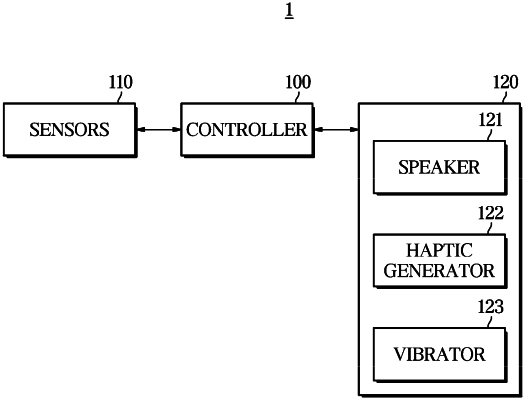| CPC B60W 50/0098 (2013.01) [A61B 5/0205 (2013.01); A61B 5/165 (2013.01); A61B 5/18 (2013.01); A61B 5/6893 (2013.01); B60N 2/002 (2013.01); B60W 50/16 (2013.01); G06V 20/597 (2022.01); A61B 5/024 (2013.01); A61B 5/369 (2021.01); B60N 2/976 (2018.02); B60W 2050/143 (2013.01); B60W 2540/22 (2013.01); B60W 2540/221 (2020.02); B60W 2540/223 (2020.02)] | 12 Claims |

|
1. A vehicle comprising:
a plurality of sensors mounted on a seat;
an output device; and
a controller configured to:
obtain an acceleration in each of a first seat in contact with a driver's back and a second seat in contact with a driver's thigh through the plurality of sensors;
determine a specific frequency in each of the first seat and the second seat;
determine contact pressure information and load information of each of the first seat and the second seat via the plurality of sensors;
determine a human vibration sensitivity using at least one of the specific frequency, the contact pressure information, and the load information;
determine driver's emotional information including positive emotional information and arousal emotional information based on the human vibration sensitivity; and
control the output device according to the driver's emotional information;
wherein the controller is further configured to perform an emotional modeling based on the driver's emotional information;
wherein the controller is further configured to perform the emotional modeling using a quadrant graph having the positive emotional information as a horizontal axis and the arousal emotional information as a vertical axis;
wherein the controller is further configured to set a moving pattern in each quadrant of the quadrant graph so the driver's emotional information changes to the positive emotional information; and
wherein, in response to a case where the driver's emotional information is one of a pattern moving from a second quadrant to a first quadrant, a pattern moving from the second quadrant to a fourth quadrant, a pattern moving from a third quadrant to the first quadrant, and a pattern moving from the third quadrant to the fourth quadrant, the controller is configured to determine that a driver's emotion changes to a positive emotion.
|